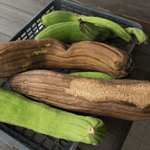Subscribe and save 10%!

Loofah / Sponge Gourd (Luffa aegyptiaca)
28 SEK
Unit price perExpected delivery date: 20 December to 27 December.
Applies to orders within Sweden. For other countries - see our delivery terms .
In stock - Ready to be shipped
Share
SEEDS (15pcs/bag)
Trivial name: Loofah, Mushroom cucumber, Wash sponge cucumber, Bath sponge creeper
Scientific name: Luffa aegyptiaca
Family: Cucurbitaceae
Plant history & use:
Cultivated and used since the fourth century in the Roman Empire. Young fruits were eaten, ripe fruits were used as bath sponges. Loofah mushrooms were until WWII the most used mushroom in the United States.
The young, green fruit is eaten as a vegetable like ordinary cucumber. Quite early in the life of the fruit, it begins to form a distinct fibrous structure on the inside. On a fully ripe fruit, the skin easily peels off the fibrous interior, resulting in a near-perfect sponge that can be used in the same way as our regular household sponges - on the counter, in the bathroom or as a cleaning sponge.
An advantage of using a loofah sponge is that it stays fresh significantly longer than a "regular" synthetic sponge.
If you cut the loofah sponge along the long side so you can turn the sponge inside out, you can use the more textured inside as a stronger scrub and the smoother outside as a softer scrub.
Edible young shoots, leaves and flowers - a common way is to "stir" leaves and shoots in a little soy sauce etc. Asian sauces. Seeds left over after harvesting ripe luffa can be roasted and eaten like pumpkin seeds.
The fibers that run along the long side of the fruit's edges are durable and can be used as cords for tying up other plants, for example.
Culture:
Mushroom cucumber wants to be in a sunny location with good water supply. Grows best in locations with sunlight throughout the day. If you have a greenhouse, it is a perfect place for the mushroom cucumber.
Thrives best in a loamy, well-drained and nutrient-rich soil. Regular nutrient supply is preferred.
Provide plenty of room for climbing for optimal growth.
At first, the fruit is firm in shape and green in color. It is when the fruit is around 10 cm that the fruit is edible. Soon after that a fibrous structure begins to form inside the skin that makes the fruit unsuitable for edible purposes.
When the fruit becomes lighter and the skin begins to feel looser against the inside and the color turns yellow to brownish, the fruit is ready to be harvested. Preferably harvest the fruits before they turn completely brown and the skin becomes dry, it can be difficult to peel the fruits without damaging the inside otherwise.
Pinch the fruits off the vine and let them dry for another day before soaking them for a couple of hours to help remove the skin. Do not soak for longer than 1 day as bacterial growth can occur. Remove seeds by opening the bottom of the fruit and shaking them out. Scale. Rinse the loofah sponge with water to remove loose plant debris. Lay to dry again - out in the sun protected from rain works great.
Should you, after all, let the fruits remain on the plant until they are completely brown and dry, it is easiest to remove the skin with an ordinary kitchen knife after soaking.
If it starts to approach the risk of frost and your fruits still don't look ready, an early harvest is still recommended, as repeated exposure to frost damages foliage and fruits can suffer from rot. Pinch off the fruits and hang them indoors with the skin on to dry. When you see that the shell goes from firm to loose (slightly shriveled appearance) and the color changes to brownish, it is time to open the shell.
The flowers are bright yellow.
Fruits can reach 75 cm in favorable conditions.
Sowing:
The mushroom cucumber needs some time to develop mature (strongly) fibrous fruits. So preferably already in February/March and start up indoors. When the risk of frost is over, the plants can be planted/exhibited.
Soak seeds 1 day in advance. Sow seeds in seed soil, cover with a thin layer of soil. Keep the seed moist. In order to more easily maintain good humidity, the seed can be covered with plastic foil provided with air holes.
Characteristics:
Lifespan: Perennial
Location: Sun
Height: 2 meter
Germination Time: 5-20 days
USDA Zone: 10-12
- Choosing a selection results in a full page refresh.
- Opens in a new window.









